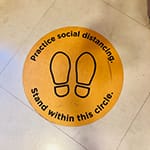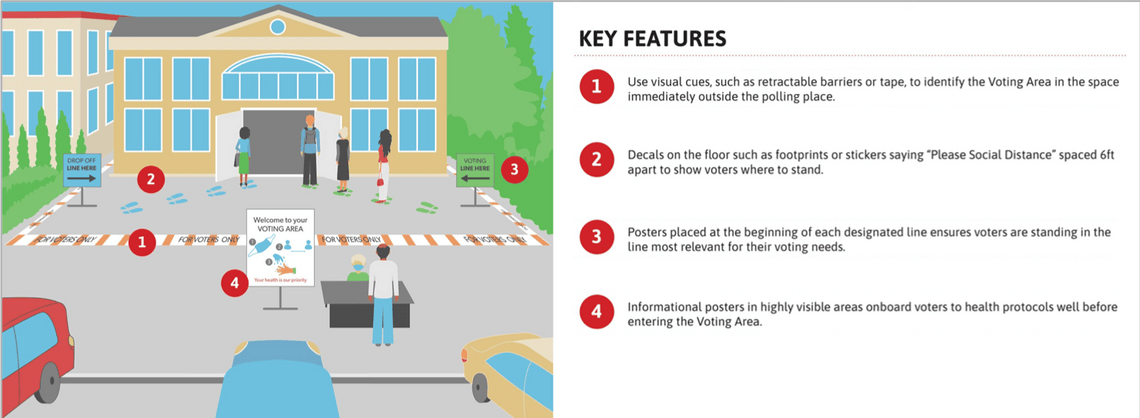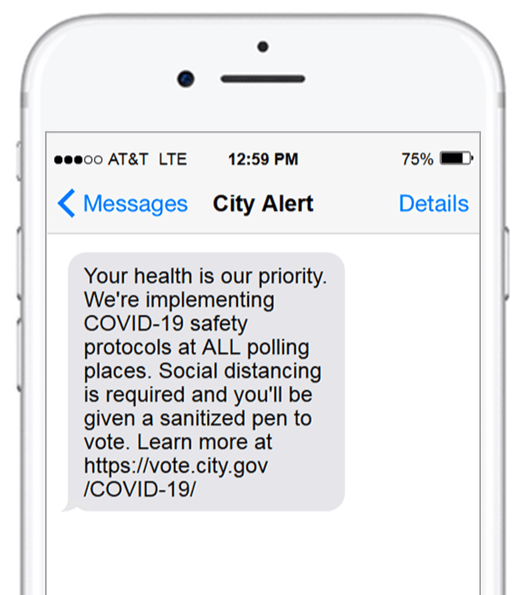HIGHLIGHTS
- Reorient the layout and visual cues to encourage safe practices
- Enlist community leaders to validate safety protocols
- Demystify the voting process through proactive communication
There will always be voters who prefer to cast a ballot at a physical polling place, which means.in-person voting needs to be an accessible option in 2020. The onus is on election officials to ensure that polling places and processes are safe, even if a high number of voters cycle through. Officials should provide voters with clear instructions and protocols that reduce health risks and minimize the likelihood of noncompliance. They should also preview safety measures in advance of the election to assuage concerns that may deter some from voting in person.
The flow and layout of polling places will determine whether voters are kept safe while casting their ballots. But even the most well-intentioned protocols will only be successful if they are immediately clear, easy to follow, and simple to enforce.
The flow and layout of polling places will determine whether voters are kept safe while casting their ballots. But even the most well-intentioned protocols will only be successful if they are immediately clear, easy to follow, and simple to enforce. Fortunately, a few basic design elements can go a long way in protecting voters and guiding them through safe voting practices.
Download a pdf of the Voting Area Diagram here.
- Expand the footprint of polling places and posted instructions
Designate a large perimeter around polling locations where posted instructions begin to give voters a moment to understand and adopt required safety procedures far before reaching more crowded areas. Clear signage should indicate when voters are entering “Voter Areas” to create a sharp mental shift toward increased safety behaviors. In addition, voters who lack protective equipment should be given face masks (and in some cases gloves) and directed on their proper usage. If a person is unwell or unwilling to comply with safety directives, they should be separated from other voters.
- Dedicated lines for ballot drop-off
Create two separate lines for voters: one for those dropping off pre-filled ballots and one for those who are casting a ballot at the polling place. Some voters who request a mail ballot will prefer to hand it off personally to election workers. Making available the opportunity to do so is a good idea, but having these voters wait in long lines poses an unnecessary health risk. Clear signage explaining the dual lines should be visible throughout the site to properly direct voters and minimize perceptions of unfairness.By accepting drop-off ballots separately, workers can process voters more quickly and reduce the overall number of people at polling places at any one time.
- Provide redundant guidance throughout the voting process
With new safety protocols in place, the voting experience this year will be unfamiliar even to the most seasoned voter. Clear and simple guidelines on how to cast a ballot can reduce voter confusion and increase the likelihood that safety procedures are consistently followed. Use signage, floor markings, and other visual cues to guide voters step-by-step through the in-person voting process. Basic instructions should be reinforced with markers and cues in the physical space (floor decals, navigation signage, etc.) that keep voters at a safe distance from one another and encourage proper use of voting equipment to limit the spread of the coronavirus.
Invite community leaders to pilot voting procedures at local polling places. Voters may have concerns about the government’s ability to protect their health at voting sites. And these sentiments may be especially pronounced within communities disproportionately impacted by COVID-19. Election
Invite community leaders to pilot voting procedures at local polling places. Voters may have concerns about the government’s ability to protect their health at voting sites. And these sentiments may be especially pronounced within communities disproportionately impacted by COVID-19. Election officials could mitigate this problem by creating more transparency around new safety protocols and previewing them to voters through trusted channels.
While health experts should be in charge of developing safety standards for in-person voting, trusted community leaders can assist in verifying the fidelity of these procedures. Polling places can host ‘dry-runs’ of the in-person voting process with church leaders, local organizers, the media, and other influential community members to both garner feedback and build support. During the dry-runs, attendees can document their experience and share it widely through their networks. These outreach efforts from credible sources would give voters a clear sense of the safety precautions being implemented at polling locations while increasing their trust in the process.
Changes to the voting process in response to the public health crisis can leave voters feeling uncertain or uneasy about casting a ballot. Election officials should preview new procedures and provide advance safety information to familiarize voters with the new
Changes to the voting process in response to the public health crisis can leave voters feeling uncertain or uneasy about casting a ballot. Election officials should preview new procedures and provide advance safety information to familiarize voters with the new in-person voting experience. Notify residents about how and where to vote safely through existing city email and SMS alert systems at key moments. Using existing alert channels allows a wider audience to be reached and underscores the importance of safe participation feels appropriate given the potential health implications of voting during the pandemic. In the days prior to the polls opening, alerts could be sent out that address safety protocols, list the nearest polling places, and walk-through the typical process for voting on Election Day and during early voting periods.
In addition to reducing ambiguity, this level of information and transparency can give voters a greater sense of control over their own safety. Demystifying the process will also generate goodwill and build confidence in it. While voters should be able to sign up for these notifications independently, using existing alert channels allows a wider audience to be reached and feels appropriate given the health risks of voting during the pandemic.








